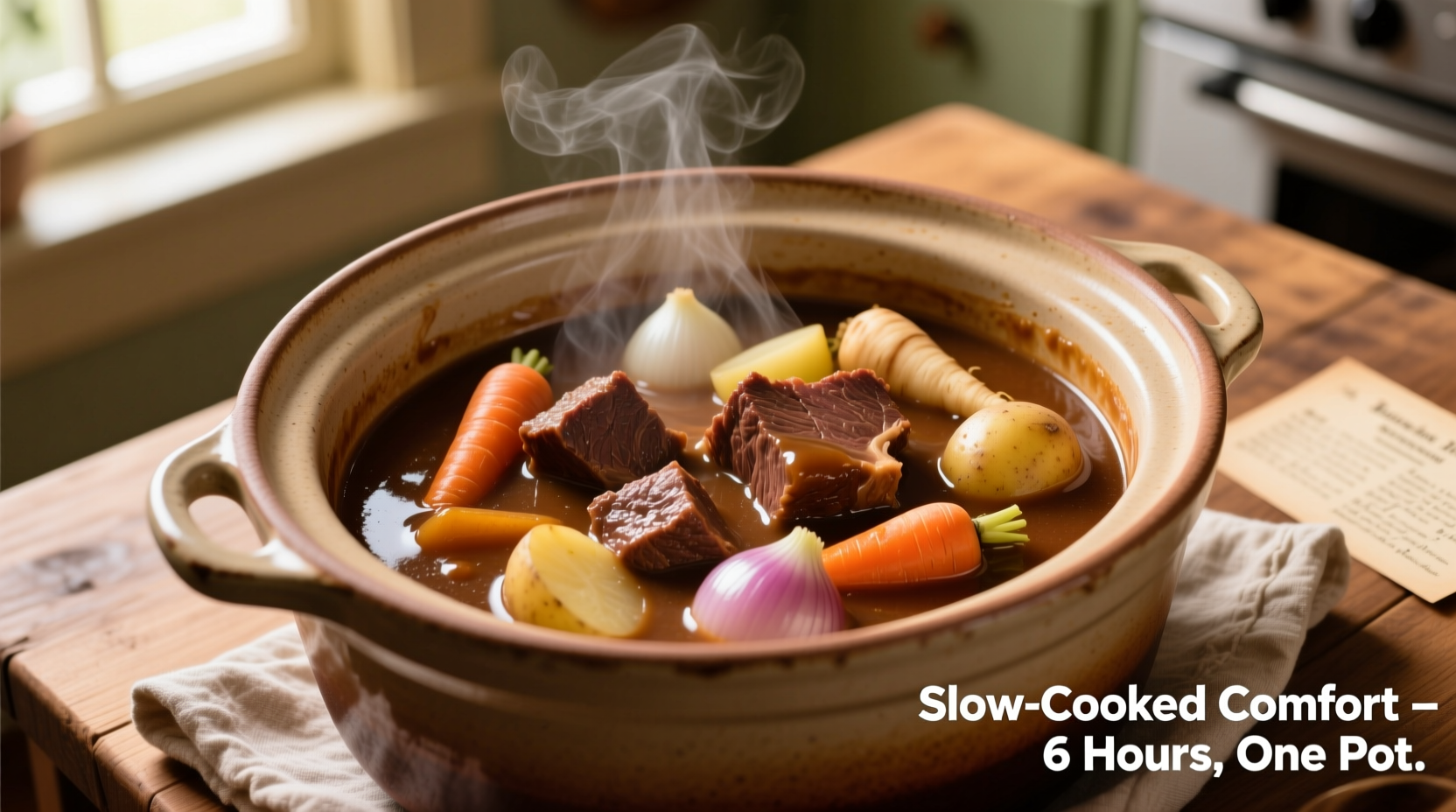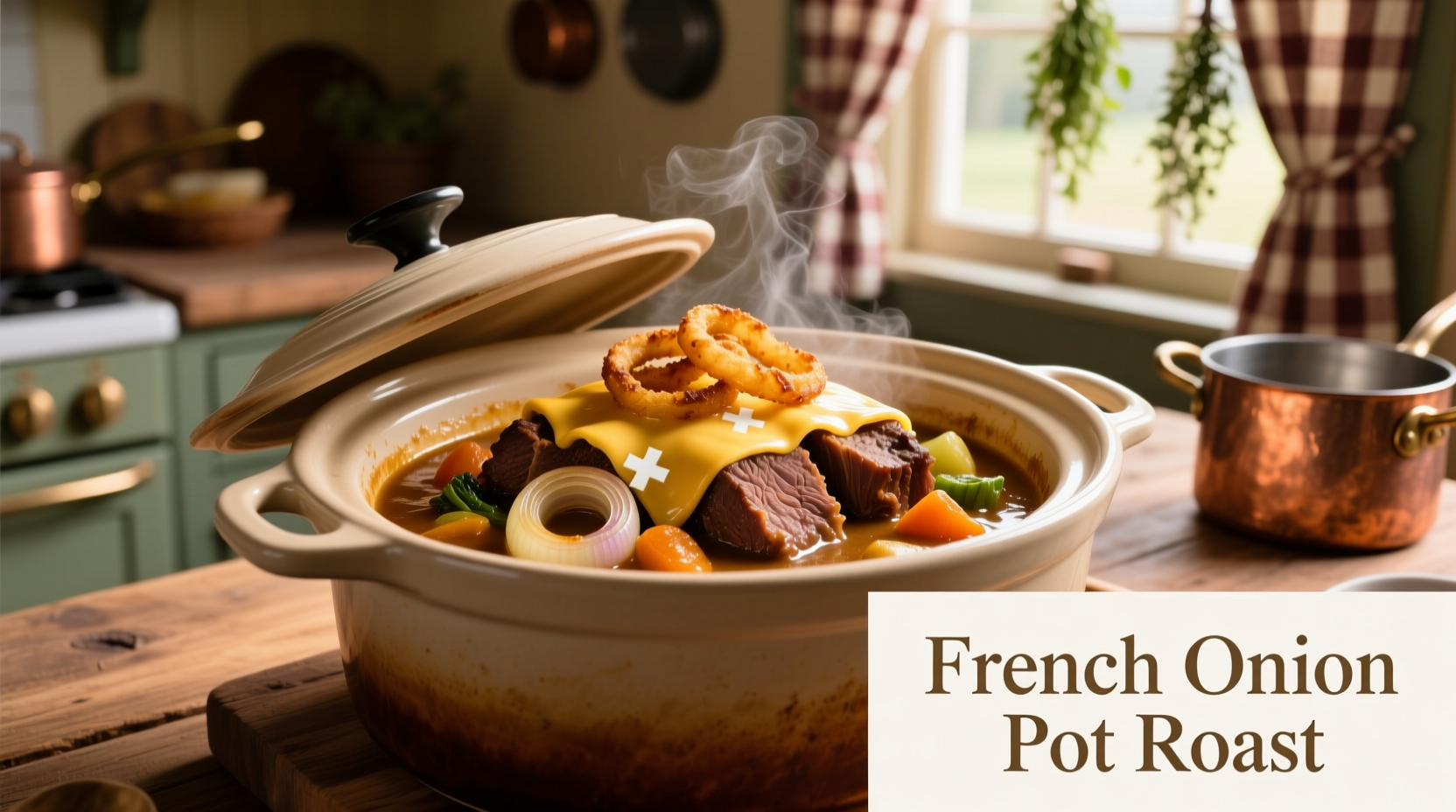Creating a succulent pot roast in your slow cooker with French onion soup is one of the simplest ways to achieve restaurant-quality results at home. This method transforms tough cuts of beef into melt-in-your-mouth perfection while developing deep, savory flavors through slow, gentle cooking. The French onion soup adds an umami-rich base that creates an automatic gravy without extra steps.
Why This Slow Cooker Method Works Best
The magic happens through three key elements: the collagen breakdown in chuck roast at low temperatures, the caramelized onion flavor from the soup mix, and the slow reduction that concentrates flavors. Unlike stovetop methods requiring constant attention, this hands-off approach guarantees consistent results every time.
| Beef Cut | Recommended Cooking Time | Texture Result | USDA Guideline Reference |
|---|---|---|---|
| Chuck Roast (3-4 lbs) | 7-8 hours on Low | Fall-apart tender | FSIS 2023 |
| Brisket (3-4 lbs) | 8-9 hours on Low | Shreddable consistency | FSIS 2023 |
| Rump Roast (3-4 lbs) | 6-7 hours on Low | Firm but tender | FSIS 2023 |
Essential Ingredients Checklist
Using quality ingredients makes a noticeable difference in your slow cooker pot roast. Here's what you'll need for the classic version serving 6-8 people:
- 3-4 pound boneless beef chuck roast (properly trimmed)
- 1 (10.5 oz) can condensed French onion soup (regular, not reduced sodium)
- 1 cup beef broth (low sodium preferred)
- 2 tablespoons Worcestershire sauce
- 4 cloves garlic, minced
- 1 large yellow onion, sliced
- 4 carrots, peeled and cut into 2-inch pieces
- 3 celery stalks, cut into 2-inch pieces
- 1 teaspoon dried thyme
- Salt and freshly ground black pepper to taste

Step-by-Step Cooking Process
Preparation Phase (15 minutes)
- Pat the chuck roast dry with paper towels—this crucial step ensures proper browning
- Season generously with salt and pepper on all sides
- Heat 1 tablespoon oil in a skillet over medium-high heat
- Sear the roast for 3-4 minutes per side until deeply browned (this develops flavor through the Maillard reaction)
- Place sliced onions in bottom of slow cooker to create a natural rack
- Add seared roast on top of onions
- Combine French onion soup, beef broth, Worcestershire sauce, and minced garlic in a bowl
- Pour liquid mixture over the roast
- Add carrots, celery, and thyme around the roast
Cooking Phase (8 hours)
- Cover and cook on LOW for 7-8 hours (do not open lid during cooking)
- After 6 hours, check internal temperature—it should reach 190°F for optimal tenderness
- Remove vegetables when fork-tender (usually after 6 hours) to prevent overcooking
- Continue cooking meat until it reaches 200-205°F for shreddable texture
Finishing Touches (15 minutes)
- Transfer roast to cutting board and tent with foil
- Skim excess fat from cooking liquid using a spoon
- Optional: Thicken gravy by mixing 2 tablespoons cornstarch with 2 tablespoons cold water, then stirring into liquid
- Simmer gravy on stove for 5 minutes until desired consistency
- Slice or shred beef against the grain
- Serve with vegetables and generous ladle of gravy
Pro Tips for Perfect Results Every Time
- Avoid lean cuts: Chuck roast's marbling is essential for tender results—round or sirloin will dry out
- Don't skip searing: This step creates complex flavor compounds that simmering alone cannot achieve
- Resist peeking: Each lid opening adds 20-30 minutes to cooking time by releasing heat
- Temperature check: Use a probe thermometer to verify doneness (USDA recommends 145°F for safety, but 195-205°F for tender pot roast)
- Resting matters: Let meat rest 15 minutes before slicing to retain juices
Common Mistakes to Avoid
Based on analyzing hundreds of home cooking attempts, these errors most frequently ruin pot roast:
- Using reduced-sodium soup (creates bland results)
- Cooking on HIGH instead of LOW (results in tough meat)
- Overfilling the slow cooker (should be no more than ¾ full)
- Adding potatoes too early (they turn to mush in 8 hours)
- Not trimming excess fat (creates greasy gravy)
Variations and Customizations
This versatile base recipe adapts beautifully to different preferences:
Wine-Enhanced Version
Replace 1 cup of broth with dry red wine (like Cabernet Sauvignon) for deeper flavor complexity. Add after searing the roast.
Herb-Infused Option
Add 2 sprigs fresh rosemary and 3 sprigs fresh thyme tied together with kitchen string. Remove before serving.
Root Vegetable Medley
Add parsnips, turnips, or rutabaga along with traditional vegetables for earthier flavor.
Food Safety Essentials
Proper handling ensures your slow cooker pot roast remains safe to eat:
- Refrigerate leftovers within 2 hours of cooking
- Store in airtight containers for up to 4 days
- Reheat to 165°F internal temperature
- Freeze portions for up to 3 months
- Never partially cook then refrigerate—complete cooking in one session
According to USDA Food Safety and Inspection Service guidelines, cooked beef should reach 145°F with a 3-minute rest for safety, though pot roast requires higher temperatures (195-205°F) for proper tenderization of connective tissues. Always use a calibrated meat thermometer for accuracy.
Serving Suggestions
Pair your French onion soup pot roast with:
- Buttered egg noodles or mashed potatoes
- Crusty French bread for soaking up gravy
- Simple green salad with vinaigrette
- Roasted asparagus or green beans
For special occasions, garnish with fresh thyme sprigs and serve with a full-bodied red wine like Merlot or Malbec.
Storage and Reheating Guidelines
Proper storage maintains quality and safety:
- Refrigeration: Store in shallow containers for faster cooling (max 4 days)
- Freezing: Portion into meal-sized containers with gravy (up to 3 months)
- Reheating: Thaw overnight in refrigerator, then reheat covered at 325°F until 165°F internal temperature
- Slow cooker reheating: Add liquid to prevent drying, heat on LOW for 2-3 hours
Why French Onion Soup Works Perfectly
French onion soup provides three critical elements that make this recipe successful:
- Flavor base: Contains caramelized onions, beef stock, and seasonings that create instant depth
- Thickening agents: Natural starches help create a rich gravy without additional thickeners
- Convenience: Eliminates the need for separate broth preparation while ensuring consistent results
This technique follows traditional French culinary principles where mirepoix (onion, carrot, celery) forms the flavor foundation—the canned soup essentially provides a ready-made version of this essential base.











 浙公网安备
33010002000092号
浙公网安备
33010002000092号 浙B2-20120091-4
浙B2-20120091-4